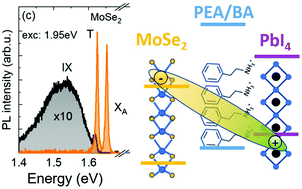Interlayer excitons in MoSe2/2D perovskite hybrid heterostructures – the interplay between charge and energy transfer†
Abstract
van der Waals crystals have opened a new and exciting chapter in heterostructure research, removing the lattice matching constraint characteristics of epitaxial semiconductors. They provide unprecedented flexibility for heterostructure design. Combining two-dimensional (2D) perovskites with other 2D materials, in particular transition metal dichalcogenides (TMDs), has recently emerged as an intriguing way to design hybrid opto-electronic devices. However, the excitation transfer mechanism between the layers (charge or energy transfer) remains to be elucidated. Here, we investigate PEA2PbI4/MoSe2 and (BA)2PbI4/MoSe2 heterostructures by combining optical spectroscopy and density functional theory (DFT) calculations. We show that band alignment facilitates charge transfer. Namely, holes are transferred from TMDs to 2D perovskites, while the electron transfer is blocked, resulting in the formation of interlayer excitons. Moreover, we show that the energy transfer mechanism can be turned on by an appropriate alignment of the excitonic states, providing a rule of thumb for the deterministic control of the excitation transfer mechanism in TMD/2D-perovskite heterostructures.



 Please wait while we load your content...
Please wait while we load your content...